The Children of the “Tour”
As part of a traineeship project for her Bachelor’s Degree in Historical Science and Heritage studies at Université Laval, Farah Verret had the opportunity to work with the “Fonds Enfants abandonnés” at the archives centre of Le Monastère des Augustines. The Fund includes records, notes, correspondence and extracts from parish registers. With a goal to “understand and share the Fund,” Verret scanned 600 notes and literally transcribed 515 of these documents in anticipation of their possible release online. She wrote this article about “The Children of the Tour” as part of her internship experience at the archives centre.
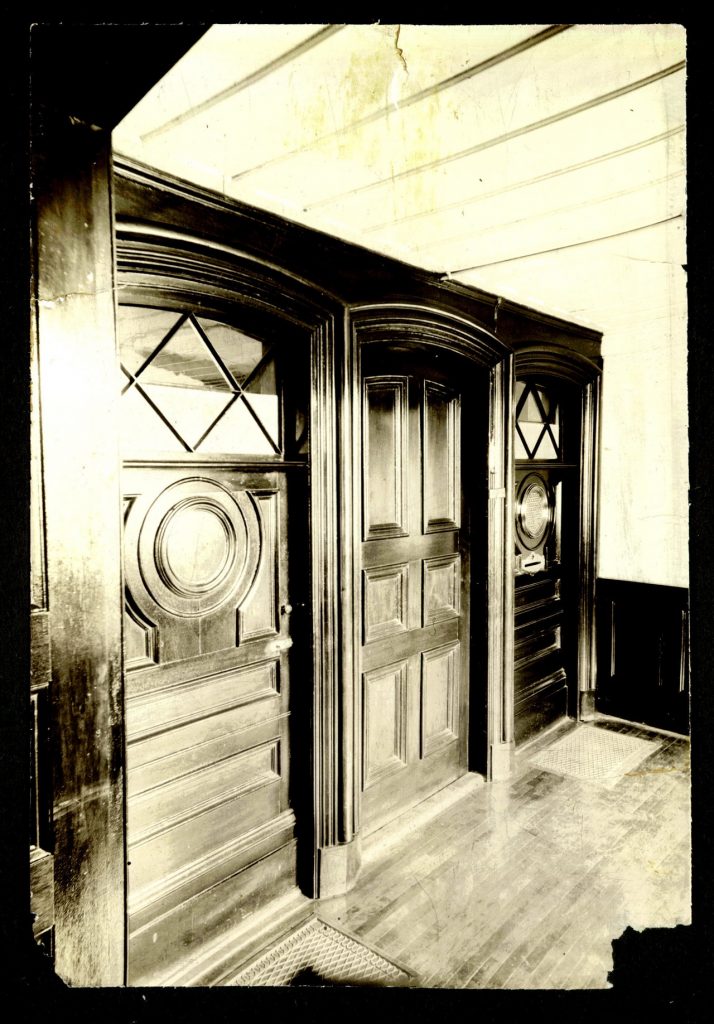
Photo Livernois, 1927. (HDQ-F1-N1,2_13_8)
© Archives du Monastère des Augustines
Most visitors to Le Monastère des Augustines’ museum have passed by the “tour[1]” door. It was often seen as the cloister’s symbol, enabling the nuns to manage visitors and collect donations left by outside citizens for the community. People also left mail and other items for the Hôtel-Dieu de Québec monastery’s nuns. In a way, the tour provided a restricted exchange with the outside world, while respecting the monastery’s space, which was reserved for the nuns. This large cylindrical wood design was equipped with a rotating mechanism, so outsiders could deposit items without seeing the nuns.
In addition to this kind of “normal” use, the Hôtel-Dieu monastery tour in Québec City was also used during a little-known period in the city’s history: the abandonment of children during the 19th century. In fact, between 1801 and 1845, the Augustinian Sisters took in nearly 1400 children abandoned in the tour and looked after placing them with foster families. From the moment a baby was left in the tour, the nuns took responsibility for the child until it was finally placed with a family. Let’s take a closer look at this remarkable time in the history of the Hôtel-Dieu de Québec.
Why take care of abandoned children?
At the beginning of the 19th century, Québec City was an important port where the population was constantly changing. It is said that economic vitality also caused a loose of morals; demographic data reveals an increase in the number of children abandoned by their parents. There were many reasons for abandonment. Sometimes the mother was a young girl. Other times, it was due to “illegitimate” unions or a lack of financial resources, etc. The influence of the Catholic religion and its conjugal morality ensured that unwanted pregnancies were often hidden. The provincial government at the time stated that it was very concerned about these social practices; newborns were left in public places, such as church benches, in baskets or even in the streets.[2]
This situation forced the authorities to ask for the Augustinian congregation’s help in taking in children without families. The nuns were initially reluctant to fulfill this request, as their primary purpose was to provide care for the sick and to respect their religious vows. On the other hand, they considered that because of the government’s financial support, they would willingly accept, in particular due to “humanitarian concern.” Sister Saint-François, the Mother Superior at the time, decided to accept the Government of Lower Canada’s request and to rescue these children entrusted to them. On March 3, 1801 she wrote, “through this we will keep many small creatures alive that perish every day for lack of people who care for them… we could give them a Christian education that would provide them with morality and which would undoubtedly contribute to the salvation of many.[3]” It was through this perspective that the nuns opened their arms to these neglected children.
Nature of the agreement
The agreement struck with the authorities included the government’s coverage of childcare costs and the hiring of a secular woman who was primarily responsible for taking care of children for a certain period of time. They began to collect the unfortunate children within the monastery tour. The tour was equipped with a bell that was used to notify the Tourière sister that something was just left behind. In some cases, it was a child, who was taken and quickly baptized, if it had not already been done, and brought to the hospital. After this stage, the children were placed with a nanny, generally in the countryside. These children, usually very young, were sometimes provided with notes left by the parents or by their parish priest. The notes contained various information; sometimes it’s a letter that explain the reasons for abandonment. Other times, only the child’s name with a request for baptism was indicated.
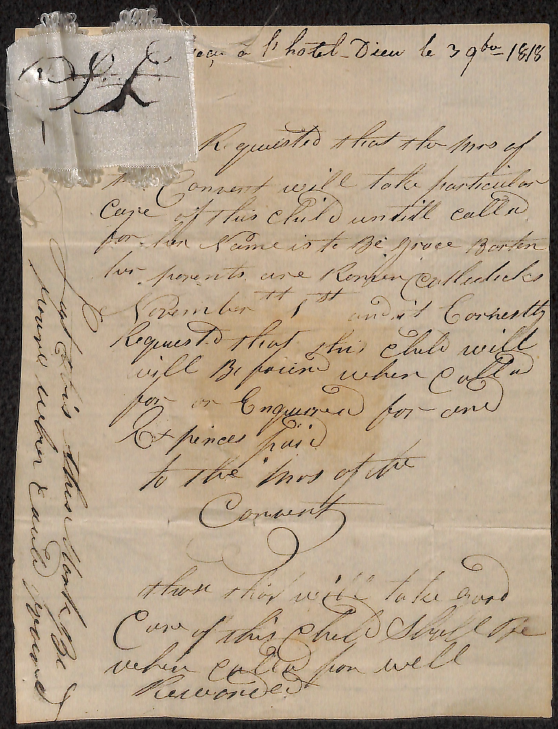
Fonds Enfants abandonnés
(HDQ-F3-B1/1:33)
© Archives du Monastère des Augustines
The notes of abandoned children
Because of the Augustinian’s great concern for record keeping, notes and correspondence about abandoned children were kept. All were numbered for convenience, and there were two main types of notes. The first were notes received at the same time as children. These were usually produced by parents, a doctor or a priest. There were notes that indicated the reason for abandoning the child. For example, in note 123, it indicated that “the father is absent from the country and has abandoned his wife […] and the mother and grandmother live together in great poverty and distress.”[4] Other notes promise that the child will be re-claimed when the parents’ conditions are adequate. Note 7, dated November 28, 1814, bears witness to such a situation. It reads that “the mother of the child’s intention is to recover and will return when that time comes. I pray that this dear child is surrendered to no one but the one who will make a request of such in writing.[5]”
The second type of note was written by the children’s parish priest. When the children were received, the nuns made sure that the children were baptized. A note written by Sister Saint-Pierre, dated March 15, 1822, testifies to the importance given to baptism. She wrote: “Sir, we do not find the baptism of Pierre Hébert in the parish, which gives me great anxiety.[6]” On the same note, a priest confirms a baptism on March 28, 1822. Other notes present a request for the child. For example, in 362, priest Louis-Antoine Montminy mentioned that “Charles Drouin still wants to have one of the children left behind, if possible.” Note also that a good number of notes are excerpts from the Registery of Baptisms and Burials.
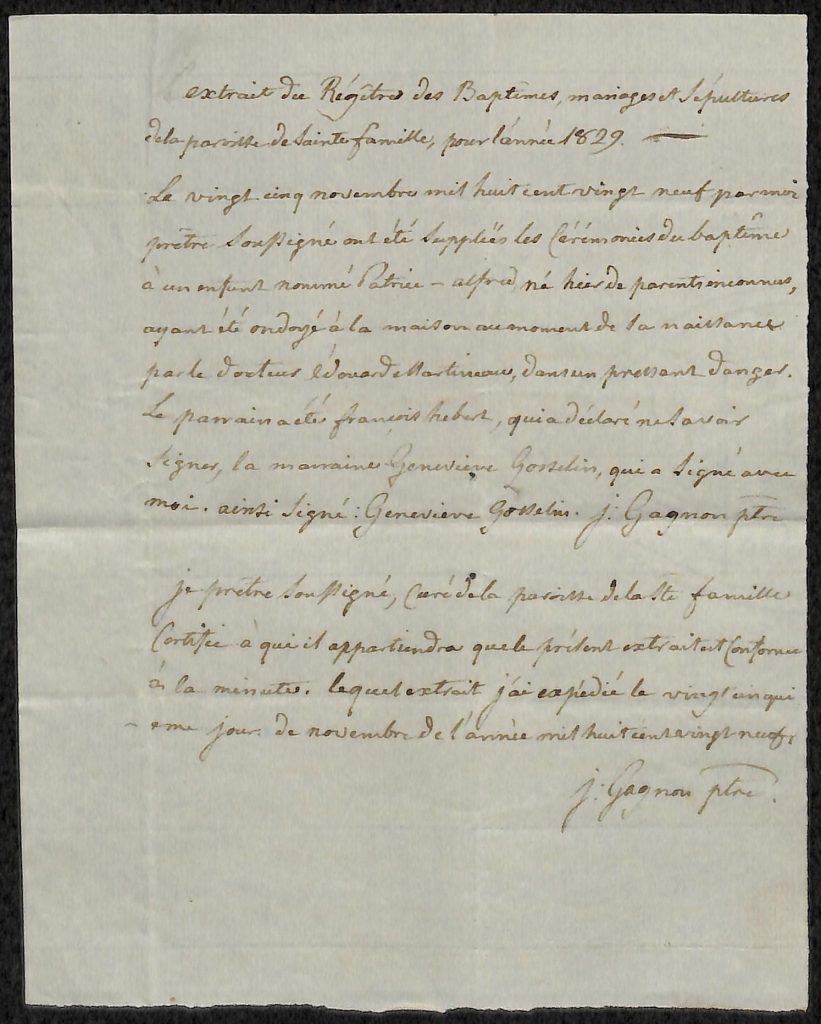
Fonds Enfants abandonnés (HDQ-F3-B1/1:494)
© Archives du Monastère des Augustines
The role of the nanny and government
Under the nuns’ strict supervision, the children were handed over to nannies that lived in the villages surrounding Québec City. The Mother Superior of the community reserved the right to investigate women and referred to the parish priest’s recommendations to ensure the children’s safety and well-being. The government paid the orphan’s subsidy to the hospital, which administered it. This usually included a small amount of money and the provision of a few items, consisting mostly of clothing. The children lived there for about 18 months and were only removed by government commissioners who then placed them with their new families.
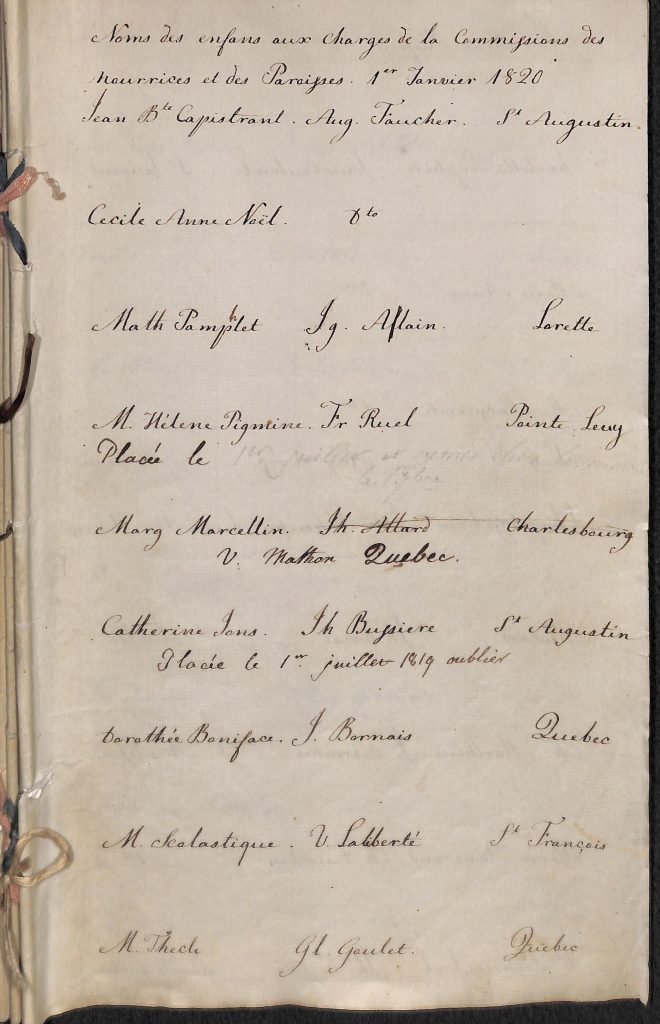
Fonds Enfants abandonnés (HDQ-F3-C1/1:2)
© Archives du Monastère des Augustines
The age at which children were placed with their family fluctuated through time. Children born between 1828 and 1845 were adopted or placed only after celebrating their fifth birthday. Before 1828, the average age was 10 or 11. On February 18, 1824, Sister Saint-Ambroise wrote to the parish priest of Sainte-Marie-de-Beauce asking for help to find adoptive families for the children left in her care. The letter reflects the nuns’ concern about their little protégés’ placement. Sister Saint-Ambroise asked to “help you place those children currently boarded in your parish in a free and adoptive way into honest families. It is too difficult for those of a tender age and it is possible for those who are 6, 7 or 8 years old.[7]” The nuns insisted on the importance of raising children in families intending to welcome them as their own.
In 1808, in order to facilitate placement, the government decided to appoint commissioners whose task was to place children of “suitable age” as apprentices with craftsmen or as domestic servants in private homes. The government instituted “contracts of commitment and learning.” These contracts bound the child until he or she was 21 years of age[8].
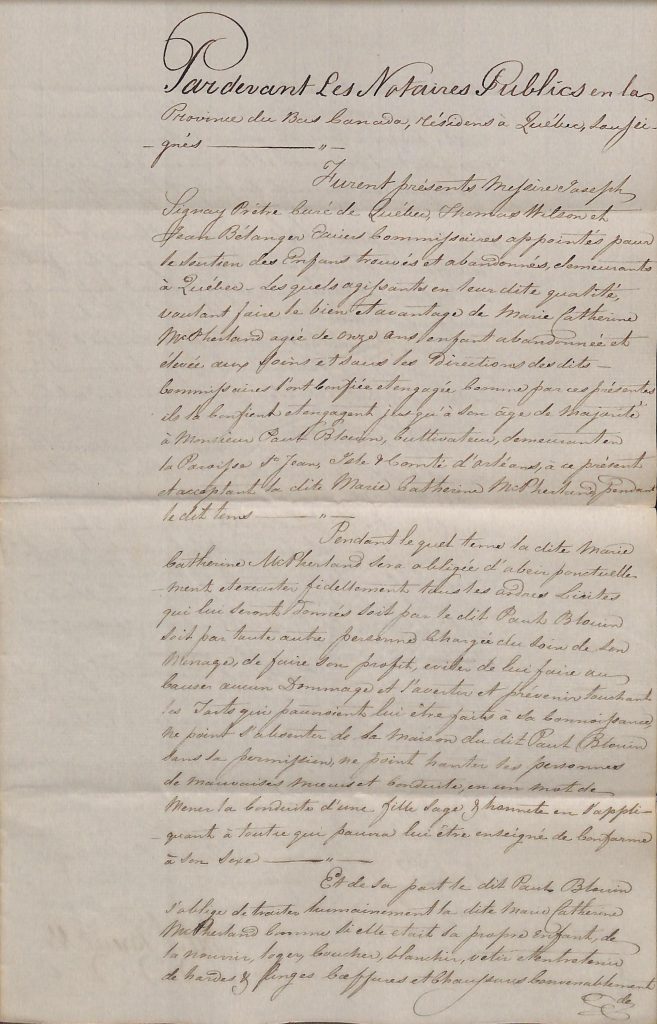
Fonds Enfants abandonnés (HDQ-F3-A1/2 :5)
© Archives du Monastère des Augustines
End of the practice at Hôtel-Dieu
By 1835, the nuns faced serious financial problems. The government gradually decreased subsidies for childcare, which affected the hospital’s budget. Each year, the nuns had to insist and negotiate firmly in order to receive a minimum of funds necessary to operate this public service, as they could not bring themselves to abandon this mission. On February 12, 1845, Sister Saint-Pierre, the depositary of the Hôtel-Dieu de Québec, learned from the Mayor of Québec City, René Édouard Caron, that the grants had been abolished definitively. From that moment, the tour had to close its door to the children, since the service was not viable without the government’s financial support. Marie Providence was the last child admitted to the tour on April 16, 1845. By 1850, the last children admitted were all placed with families[9].
The second half of the 19th century was marked by a certain standardization of care for abandoned children. In both Québec City and Montréal, nurseries and hospices were opened to meet the needs of care for the vulnerable. The Sisters of Charity of Montreal founded a community in Québec City and opened an orphanage in 1849, changing the way abandoned children were handled. In a certain way, the Augustinian Sisters of the Hôtel-Dieu passed the torch and, with the commissioners’ permission, they gave the community the tools relating to abandoned children in order to continue the work started at the Hôtel-Dieu. It should be noted, however, that the Augustinian Sisters from the Hôtel-Dieu du Sacré-Cœur, located in the Saint-Sauveur district of Québec City, also worked with children; they welcomed over 9,600 children between 1872 and 1929.
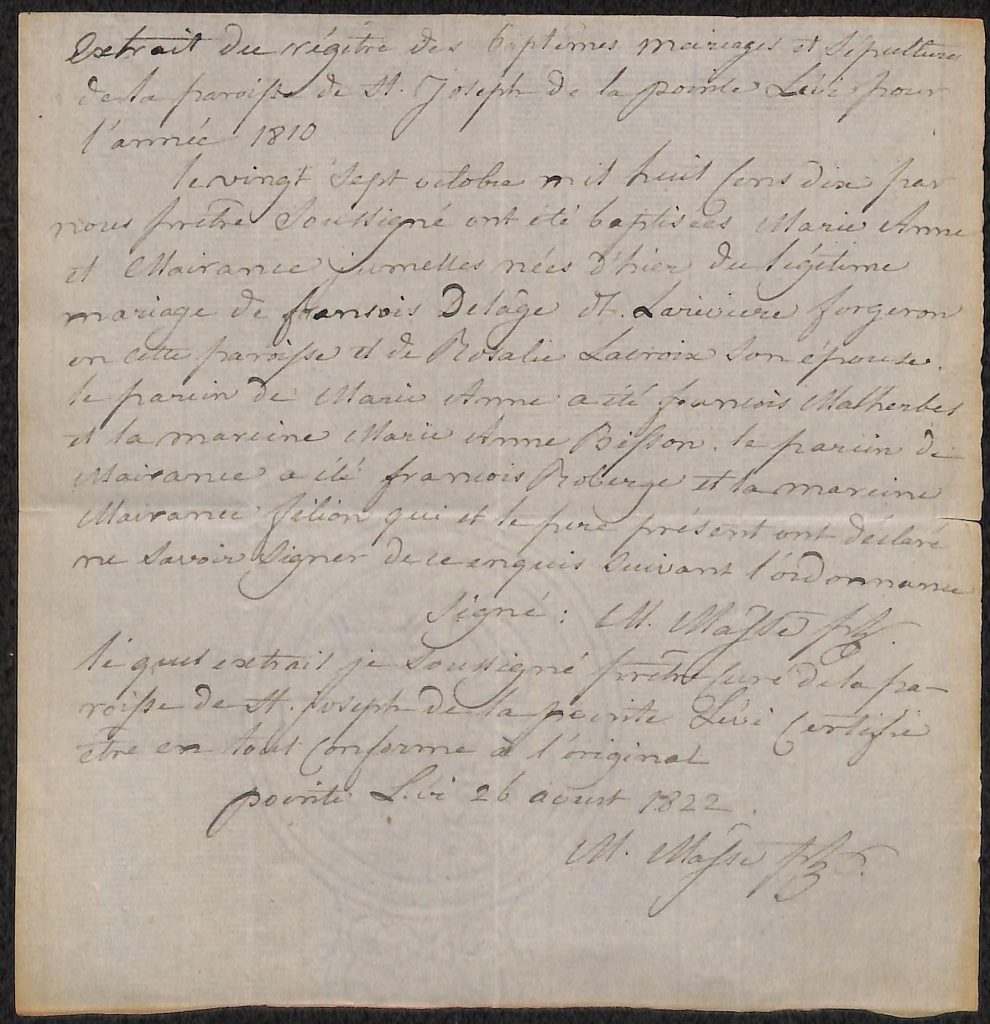
Fonds Enfants abandonnés (HDQ-F3-B1/1)
© Archives du Monastère des Augustines
***
In all, 532 children found a new family thanks to the Hôtel-Dieu de Québec’s Augustinian community. It should also be noted that 7% of the children left at the tour were returned to their parents. However, of the 1,400 children left behind in the Hôtel-Dieu monastery’s tour, more than half died in infancy. The important collaboration with the community helped meet a crying need in society of that time, and Augustinians archives bear witness to the significant and concrete actions that were put in place to provide support to families in need. In short, the monastery’s tour has served the well-being of society, even if that was not the purpose for which it was originally intended.
Farah Verret
Intern at the Centre d’archives du Monastère des Augustines
Text reviewed by Sara Bélanger and Hugues St-Pierre
[1] In a literal translation, it means tower in English. Sometimes, it can be called turn, or even found wheel . [Editor’s note]
[2] Claude Kaufholtz-Couture, Biographies des enfants abandonnés du tour de l’Hôtel-Dieu de Québec entre 1800 et 1845, Research report, Québec, 2014, p. 19.
[3] « [Que] par là nous conserverons la vie à bien des petites créatures qui périssent tous les jours faute de personnes qui en prennent soin […] que nous pourrions leur donner une éducation chrétienne qui les formerait aux bonnes mœurs et qui contribuerait sans doute au salut de plusieurs. » Lettre de Sœur Saint-François, 3 mars 1801, Québec, Archives du Monastère des Augustines. HDQ-F3-A1/1.
[4] « [Le] père est absent du pays et a abandonné sa femme […] et la mère et grand-mère vivent ensemble en grande pauvreté et détresse. » Billet d’enfant abandonné, mai 1822, Québec, Archives du Monastère des Augustines, traduction libre, HDQ-F3-B1/1 :123.
[5] « [L]’intention de la mère de la [l’enfant] ravoir et quand se tems la serà venut, je prie que cette Chere Enfant se soye livré à aucune personne que celui qui produira un requisition a se sujet qui serà de pareille écriture que celle s’y. » Billet d’enfant abandonné, 28 novembre 1814, Québec, Archives du Monastère des Augustines, HDQ-F3-B1/1 :7.
[6] « Monsieur, on ne trouve pas à la paroisse le baptême de Pierre Hébert, ce qui me donne de grandes inquiétudes. » Note de sœur Saint-Pierre, 15 mars 1822, Québec, Archives du Monastère des Augustines, HDQ-F3-B1/1 :110.
[7] « […] assister de vos soins à l’effet de placer d’une manière gratuite et adoptive dans des familles honnêtes ceux de ces enfants se trouvent actuellement en pension dans votre paroisse. Si la chose trouve trop de difficulté pour ceux d’un âge encore trop tendre et qu’elle soit possible pour ceux qui ont 6, 7 ou 8 ans. » Lettre de sœur Saint-Ambroise, 18 février 1824, Québec, Archives du Monastère des Augustines, HDQ-F3-A1/1.
[8] Renée Joyal, L’évolution de la protection de l’enfance au Québec : des origines à nos jours, Sainte-Foy, Presses de l’Université du Québec, 2000, p. 22.
[9] Claude Kaufholtz-Couture, Biographies des enfants abandonnés du tour de l’Hôtel-Dieu de Québec entre 1800 et 1845, Research report, Québec, 2014, p. 55-61.

